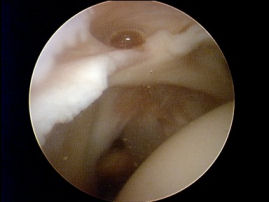Biceps Tendon
i. Biceps Anchor
This region corresponds to the origin of the long head of biceps. The biceps tendon originates from both the supraglenoid tubercle and superior labrum, [37,56] with many variations having been described. [6,37,56-63] In our study the biceps tendon originated from the supraglenoid tubercle and superior labrum in all 132 cases. No variation was noted.
ii. Intraarticular appearance of the biceps tendon
Variation in the intra-articular appearance of the biceps tendon commonly occurs and should not be misinterpreted for pathological findings. [6-7,63-66] The biceps tendon changes shapes during its intra-articular route, from round in cross-section at its origin to flatten out as it crosses the humeral head and round again as it exits the joint. [7] It appears “…about one-quarter to three eights of an inch wide…” and through an arthroscope, might not be seen in all cases as it may be appear hidden by fat and synovia which are present in the upper region of the joint.[4]
In our study, variations in the appearance of the biceps tendon were noted in seven cases. Examples of previously described variations included: Vincula biceps, the biceps tendon having a cleavage line and a partially encapsulated biceps tendon [Table 17]. [5-6] One example of a previously undescribed anatomical variant was also found, a long head of biceps suspended throughout its intra-articular route by a mesentry. No other study has noted the prevalence of intra-articular variations of the long head of biceps. No cases of an absent long head of biceps were noted.
Table 17 – Variation in the intra-articular appearance of the biceps tendon
Variant |
Prevalence (No. Of cases) |
|
Vincula biceps – “…small strands of mesentry like synovium that pass from the biceps tendon to the surrounding synovium and capsule”. [6] |
Not specified – Arthroscopic study [5] Not specified– Arthroscopic study [6] 4 cases – Arthroscopic study |
|
“…Partially or completely encased in capsular tissue”. [6] |
Not specified – Arthroscopic study [6] 1 case – Arthroscopic study |
|
Tendon may have a cleavage line running down it, thus giving the appearance of two tendons |
Not specified – Arthroscopic study [5] 1 case – Arthroscopic study |
|
Absent long head of biceps – bilateral |
1 case – Cadaveric study [7] 0 cases – Arthroscopic study |
|
Absent long head of biceps |
0 cases – Arthroscopic study 1 case - Arthroscopic study [8] 1 case – Arthroscopic study [9] 1 case – Arthroscopic study [10] 2 cases – Arthroscopic study [6]
|
|
Suspended long head of biceps |
1 case – Arthroscopic study |
iii. Biceps Pulley
The biceps pulley is a “…tendoligamentous sling…” formed by components of the rotator cuff interval. [67] At the bicipital groove, the biceps tendon exits the joint and is held in a “…U-shaped anterior suspension sling…” formed primarily by the superior gleno-humeral ligament. [68]
Variation in the biceps pulley occurs in pathological states and with shoulder movement. [68-69] In an arthroscopic study, Choi et al [68] noticed the intra-articular length of the long head of biceps changed with different arm positions, increasing in positions in which the arm is placed at the side and in neutral rotation and decreasing in length in positions of extreme abduction and external rotation as a result of the biceps pulley moving proximally.
 Biceps Pulley (arrow)
Biceps Pulley (arrow)





